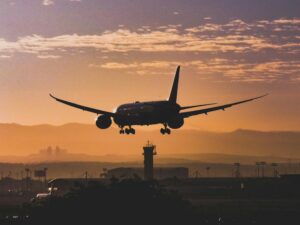Numbers rarely lie. When we look at Nigeria’s aviation statistics against comparable economies, a troubling pattern emerges.
Annual Air Passenger Traffic in Millions (2021–2024)*
| Country | 2021 | 2022 | 2023 | 2024 | Change (2023–2024) | % Change (2023–2024) |
| Nigeria | 14.25 | 16.17 | 15.69 | 15.68 | 0.0 | -0.1 |
| Egypt | 11.23 | 20.23 | 22.05 | 24.05 | 2.0 | 9.1 |
| South Africa | 20.90 | 23.99 | 24.00 | 25.68 | 1.7 | 7.0 |
| Kenya | 10.20 | 12.20 | 13.85 | 15.93 | 2.1 | 15.0 |
| Brazil | 97.69 | 112.70 | 118.30 | 120.00 | 1.7 | 1.4 |
| Indonesia | 40.60 | 70.00 | 85.10 | 95.00 | 9.9 | 11.6 |
While countries with similar economic profiles celebrate double-digit growth in air passenger traffic, Nigeria’s numbers have stagnated and even declined. This disparity demands our attention not just as an aviation issue but as a symptom of deeper structural challenges.
Recent data paints a stark picture. Nigeria recorded 15.68 million passenger movements in 2024, falling short of the previous year’s 15.69 million. More concerning is the drop from 2022’s peak of 16.17 million. This downward trajectory stands in sharp contrast to our continental neighbors and global peers.
Egypt welcomed 24.05 million passengers in 2024, a 9.1% increase from 2023. South Africa handled 25.68 million passengers, growing 7% year-over-year. Kenya’s traffic surged 15%. Beyond Africa, Brazil approached 120 million passengers in 2024, and Indonesia saw passenger numbers jump by over 5.6%.
The question posed by Chinedu Eze of ThisDay resonates powerfully: “The economy of these countries are not doing far better than that of Nigeria but why are these countries recording higher passenger traffic than Nigeria?”
The Economic Context Paradox
Nigeria maintains its position as Africa’s largest economy by GDP, yet this economic heft doesn’t translate to aviation sector performance. While economic challenges exist across all the countries mentioned, they’ve managed to insulate and even grow their aviation sectors despite these headwinds.
Nominal GDP (in USD Billions) **
| Country | 2021 | 2022 | 2023 | 2024 (Est.) |
| Nigeria | 440 | 477 | 489 | 508 |
| Egypt | 403 | 476 | 475 | 498 |
| South Africa | 419 | 405 | 398 | 400 |
| Kenya | 110 | 113 | 119 | 124 |
| Brazil | 1613 | 1840 | 2047 | 2119 |
| Indonesia | 1186 | 1300 | 1390 | 1445 |
Growth Rates by Country
| GDP Growth | Population Growth | |||||||
| Country | 2021 | 2022 | 2023 | 2024 | 2021 | 2022 | 2023 | 2024 |
| Nigeria | 3.40% | 3.25% | 2.86% | 3.84% | 2.41% | 2.41% | 2.41% | 2.39% |
| Egypt | 3.29% | 6.59% | 3.76% | 4.00% | 1.58% | 1.56% | 1.56% | 1.57% |
| South Africa | 4.70% | 1.91% | 0.60% | 0.60% | 0.84% | 0.87% | 1.00% | 1.33% |
| Kenya | 5.50% | 5.00% | 4.00% | 4.00% | 1.93% | 1.99% | 2.00% | 2.00% |
| Brazil | 4.80% | 3.20% | 3.40% | 3.40% | 0.39% | 0.40% | 0.41% | 0.41% |
| Indonesia | 3.70% | 5.31% | 5.05% | 5.03% | 0.64% | 0.74% | 0.82% | 0.82% |
The first misconception we must dispel is that GDP size, population size or growth rates determines aviation sector health. It doesn’t. Aviation thrives on a complex ecosystem of factors: regulatory environment, infrastructure quality, airline competition, currency stability, tourism appeal, and business travel demand. Nigeria struggles across multiple dimensions of this ecosystem.
Consider currency stability. While the Brazilian real, South African rand, and Egyptian pound have faced challenges, none have experienced the extreme volatility of the naira in recent years. Airlines operate on thin margins with significant foreign currency exposure for aircraft leasing, maintenance, and fuel. Currency instability creates pricing challenges that ultimately suppress demand.
Policy Frameworks That Enable Growth
Countries experiencing aviation growth have implemented deliberate policy frameworks that Nigeria has yet to adopt effectively. Brazil’s aviation sector benefited from regulatory reforms that increased competition and lowered fares. Indonesia’s government prioritized aviation infrastructure as part of its economic development strategy, recognizing air connectivity as essential for an archipelago nation.
Egypt has leveraged tourism as a key driver for aviation growth, with policies specifically designed to increase visitor numbers. The country invested heavily in airport infrastructure and marketing campaigns to position itself as a premier destination. Tourism contributes approximately 12% to Egypt’s GDP, creating a natural demand pool for aviation services.
Kenya Airways and Ethiopian Airlines have built successful hub-and-spoke models connecting Africa to global destinations, supported by government policies that recognize these airlines as strategic national assets. The Kenyan government has implemented visa reforms and destination marketing that drive tourism and business travel.
Nigeria’s aviation policy environment, by contrast, has been characterized by inconsistency and fragmentation. Multiple agencies with overlapping mandates create regulatory complexity. Policy reversals and sudden changes create uncertainty for investors and operators alike.
Infrastructure Gaps and Investment Priorities
Airport infrastructure quality directly impacts passenger experience and operational efficiency. Brazil invested heavily in airport modernization ahead of the 2014 World Cup and 2016 Olympics, with many facilities now operated by private concessionaires under performance contracts. South Africa’s airports rank among Africa’s best, benefiting from significant upgrades for the 2010 World Cup.
Indonesia launched an ambitious airport development program to support its archipelagic geography, recognizing that air travel is essential for economic integration across its 17,000 islands. The country has focused on building and upgrading regional airports to improve domestic connectivity.
Nigeria’s airport infrastructure, despite some improvements, continues to lag. The new terminal at Lagos’s Murtala Muhammed International Airport represents progress, but many regional airports remain substandard. Power outages, inadequate facilities, and operational inefficiencies persist across the network.
Infrastructure development requires sustained investment and long-term planning. Countries showing aviation growth have treated airport development as a national priority with dedicated funding mechanisms. Nigeria’s approach has been more piecemeal, with projects often delayed by funding gaps and changing priorities.
Compared to peers like Egypt and Kenya, Nigeria’s government and private sector have underinvested in aviation infrastructure, digitization, and skills development. The country suffers from insufficient incentives for private sector airline growth and innovation.
Airline Ecosystem Challenges
A robust aviation sector requires healthy airlines. Brazil’s aviation market features strong competition between multiple carriers like LATAM, GOL, and Azul. South Africa, despite SAA’s struggles, maintains a competitive market with private carriers like FlySafair and Airlink. Kenya Airways, despite financial challenges over the years, maintains extensive regional and international connectivity.
Nigeria has seen multiple airline failures over the past decade. The operating environment remains challenging, with high costs for fuel, maintenance, and financing. The collapse of Air Nigeria, Arik Air’s receivership, and other airline failures have reduced capacity and competition in the market, despite smaller new entrants to the market.
Successful aviation markets typically feature a mix of full-service and low-cost carriers serving different market segments. Nigeria’s airline ecosystem lacks this diversity, with most carriers operating similar business models and similar routes, targeting the same customer segments – against a dysfunctional, unstrategic backdrop.
Many domestic routes are underserved or lack adequate frequency. Nigeria lacks robust hub development to effectively compete regionally with countries like South Africa (Cape Town and Jo’Burg) or Kenya (Nairobi). Insufficient intermodal transport connections render air travel less convenient and more costly.
Flight delays, cancellations, and inconsistent service erode trust. Refund processes are often lengthy or denied, reducing passenger willingness to book in advance. Ticket prices are perceived as unaffordable relative to average income, particularly for domestic travel.
Although safety has improved, Nigeria still battles with a perception issue globally. High insurance premiums for Nigerian-registered aircraft drive up operational costs. Most of Nigeria’s over 30 airports operate significantly below capacity. Without an established MRO (Maintenance, Repair, Overhaul) hub, the majority of aircraft servicing must be conducted overseas, substantially increasing both downtime and expenses.
The Tourism and Business Travel Deficit
Tourism drives significant aviation demand in many growing markets. Egypt welcomed over 14 million international tourists in 2023. South Africa received nearly 8.5 million foreign visitors. Kenya’s tourism sector has rebounded strongly post-pandemic.
Nigeria’s tourism potential remains largely untapped. Despite rich cultural heritage, diverse landscapes, and vibrant cities, the country attracted fewer than 1.5 million international visitors pre-pandemic. Security concerns, visa complexities, and limited destination marketing have constrained growth in this sector.
Business travel represents another critical demand driver. Countries with growing aviation sectors have positioned themselves as regional business hubs. South Africa serves as a gateway to Southern Africa for multinational corporations. Kenya has established itself as East Africa’s commercial center. Brazil hosts Latin America’s largest business events market.
Nigeria, despite its economic size, has struggled to position itself as West Africa’s business hub. Infrastructure deficiencies, security challenges, and regulatory complexities have limited its appeal for regional headquarters and business events.
Currency and Economic Policy Impacts
Aviation is inherently dollarized. Aircraft, parts, maintenance services, and even training often require foreign currency payments. Countries with more stable currencies and foreign exchange policies create more predictable operating environments for airlines.
Nigeria’s foreign exchange challenges have created significant headwinds for the aviation sector. Airlines have faced difficulties repatriating funds, leading some international carriers to reduce capacity or withdraw entirely in the past. The naira’s volatility makes pricing challenging and creates financial uncertainty for operators.
Countries showing aviation growth have generally maintained more consistent monetary policies and worked to ensure foreign exchange availability for strategic sectors like aviation. Egypt, despite currency challenges, implemented mechanisms to ensure airlines could repatriate funds. Brazil maintained relatively open foreign exchange markets even during economic difficulties.
Lack of a clear, long-term aviation master plan hampers progress. Inconsistent government support: National carrier ambitions (e.g., Nigeria Air) have seen reversals, litigation, and unclear partnerships, which have disrupted market confidence. Regulatory bodies sometimes act more as revenue generators than facilitators, which affects ease of doing business in the sector.
The Path Forward for Nigerian Aviation
Nigeria’s aviation sector has immense potential. With over 200 million people, the largest economy in Africa, and significant diaspora communities worldwide, the fundamentals for a thriving aviation market exist. Unlocking this potential requires deliberate policy choices and strategic investments.
First, regulatory reform must create a more conducive operating environment. Streamlining the multiple agencies overseeing aviation would reduce compliance costs and improve efficiency. Consistent, transparent policies would attract investment and enable longer-term planning by operators.
Second, infrastructure development needs prioritization and funding. Public-private partnerships have proven successful in Brazil and elsewhere for airport development. Nigeria could adopt similar models to upgrade its airport network without straining public finances. But the template must be right, 80 year concessions with inexperienced concessionaires is not likely to produce the desired results.
Third, airline ecosystem development requires attention. Policies that reduce operating costs, improve access to financing, and enable different business models would foster a more diverse and resilient airline sector. Supporting the development of a strong flag carrier while enabling low-cost competition would serve different market segments.
Fourth, tourism development represents a significant opportunity. Cheaper and more simplified visa processes, destination marketing, and security improvements could unlock Nigeria’s tourism potential, creating natural demand for aviation services.
Finally, monetary policy stability is essential. Creating mechanisms to ensure airlines can access foreign exchange and repatriate funds would improve the sector’s financial sustainability and attract international carriers, and enable indigenous airlines to operate more efficiently.
Beyond the Numbers
The passenger statistics cited at the beginning tell a story beyond mere numbers. They reflect economic potential either realized or squandered. They indicate connectivity that either enables or constrains business opportunities. They represent jobs created or lost in one of the world’s most dynamic industries.
Countries showing aviation growth have recognized air connectivity as a strategic economic asset rather than merely a transport mode. They’ve implemented policies that enable growth despite broader economic challenges. They’ve invested in infrastructure that facilitates efficient operations. They’ve created conditions where airlines can operate profitably and sustainably.
Nigeria has the potential to join them. The country’s size, population, and economic fundamentals provide a strong foundation for aviation growth. Realizing this potential requires policy choices that prioritize long-term sector development over short-term considerations.
The question isn’t whether Nigeria can develop a thriving aviation sector comparable to its peers. The question is whether it will make the choices necessary to do so. The data shows what’s possible when countries prioritize aviation development. The opportunity awaits.
Notes:
*
- Nigeria: Data sourced from the Nigerian Civil Aviation Authority (NCAA).
- Egypt: Data compiled from various airport reports.
- South Africa: Data sourced from Airports Company South Africa (ACSA).
- Kenya: Data sourced from the Kenya Civil Aviation Authority (KCAA).
- Brazil: Data sourced from the National Civil Aviation Agency of Brazil (ANAC).
- Indonesia: Data sourced from Statistics Indonesia (BPS).
**
Data based on most recent data available from the World Bank and IMF. 2024 figures are estimates based on available growth projections.
Disclaimer: The insights shared in this article are for information purposes only and do not constitute strategic advice. Aviation markets and circumstances vary, and decisions should be based on your organisation’s specific context. For tailored consultancy and guidance, please contact info@avaerocapital.com.




